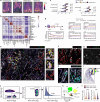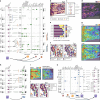Multiomic analysis of human kidney disease identifies a tractable inflammatory and pro-fibrotic tubular cell phenotype
- PMID: 40399382
- PMCID: PMC12095627
- DOI: 10.1038/s41467-025-59997-4
Multiomic analysis of human kidney disease identifies a tractable inflammatory and pro-fibrotic tubular cell phenotype
Abstract
Maladaptive proximal tubular (PT) epithelial cells have been implicated in progression of chronic kidney disease (CKD), however the complexity of epithelial cell states within the fibrotic niche remains incompletely understood. Hence, we integrated snRNA and ATAC-seq with high-plex single-cell molecular imaging to generate a spatially-revolved multiomic atlas of human kidney disease. We demonstrate that in injured kidneys, a subset of HAVCR1+VCAM1+ PT cells acquired an inflammatory phenotype, upregulating genes encoding chemokines, pro-fibrotic and senescence-associated proteins and adhesion molecules including ICAM1. Spatial transcriptomic and multiplex-immunofluorescence determined that specifically these VCAM1+ICAM1+ inflammatory PT cells localised to the fibrotic niche. Ligand-receptor analysis highlighted paracrine signaling from inflammatory PT cells mediating leucocyte recruitment and myofibroblast activation. Loss of HNF4α and activation of NF-κβ and AP-1 transcription factors epigenetically imprinted the inflammatory phenotype. Targeting inflammatory tubular cells by administering an AP-1 inhibitor or senolytic agent ameliorated inflammation and fibrosis in murine models of kidney injury, hence these cells may be a tractable target in CKD.
© 2025. The Author(s).
Conflict of interest statement
Competing interests: A.N., W.Y., N.S., C.W. are current or previous employees and shareholders of NanoString Technologies, now Bruker Spatial Biology. The remaining authors declare no competing interests.
Figures








References
-
- Tanaka, S., Portilla, D. & Okusa, M. D. Role of perivascular cells in kidney homeostasis, inflammation, repair and fibrosis. Nat. Rev. Nephrol.19, 721–732 (2023). - PubMed
MeSH terms
Substances
Grants and funding
LinkOut - more resources
Full Text Sources
Medical
Miscellaneous

